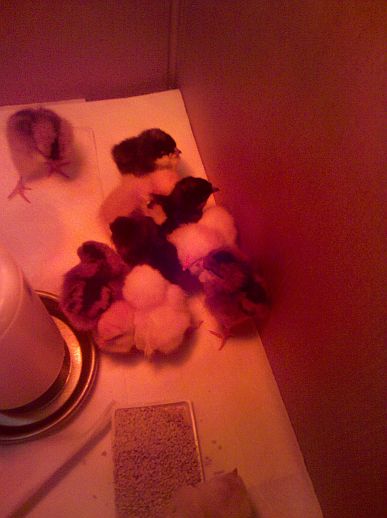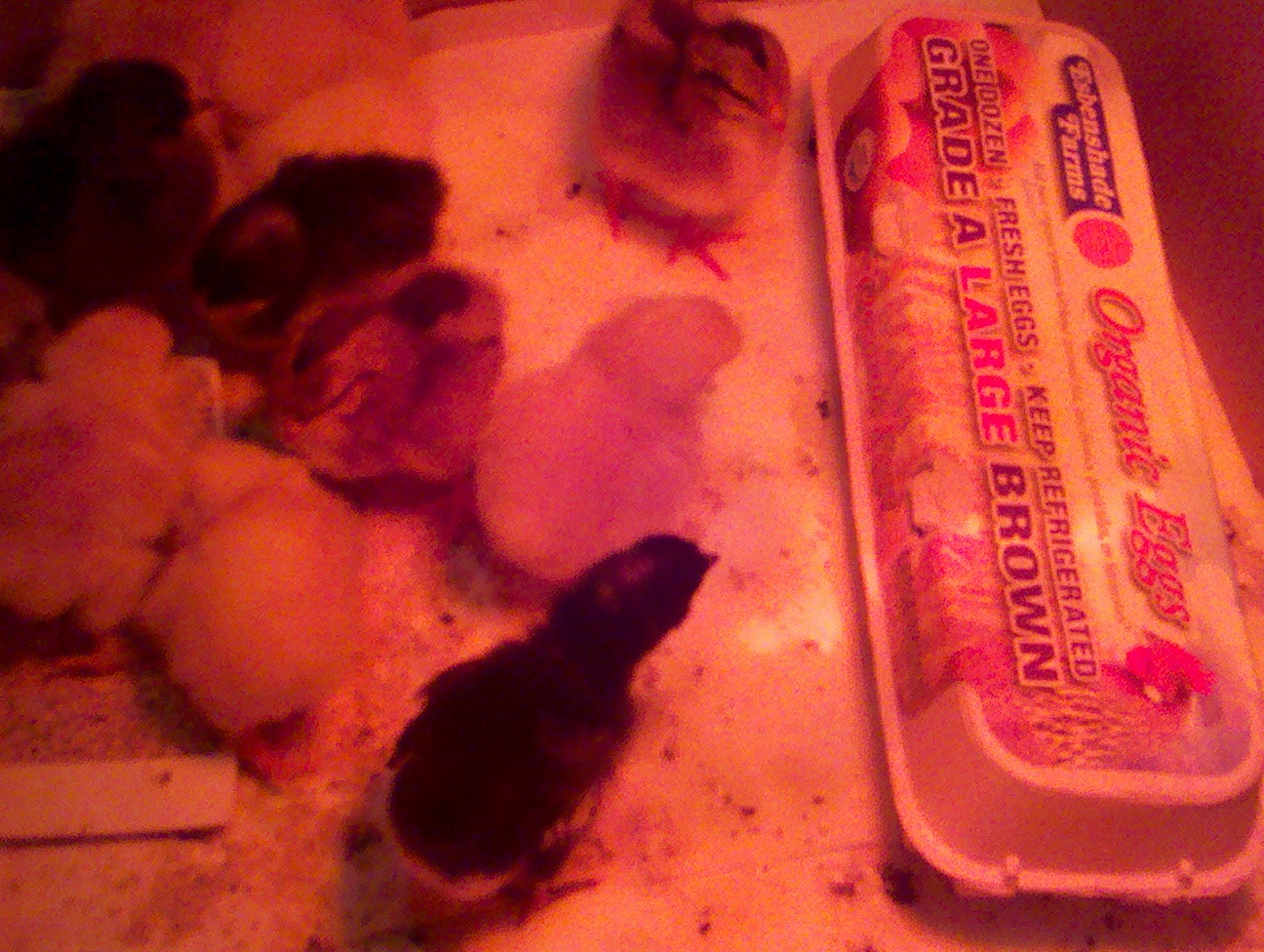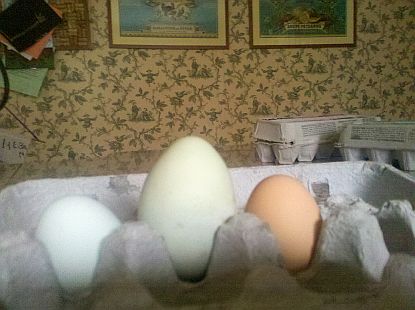There are iPhone ringtones that are designed to help bird watchers identify the calls and songs of birds they hear out in the field. While it may seem like merely good intentions for birdwatchers seeking to lure birds for the perfect photo by playing birdsong on their phones, there’s a twist to the story that is worthy of real concern.
animals
 It was Spring. I remember it vividly, because it was a cold Spring. We were still getting snow in late May. We lived in a large rental home with a very small fenced in backyard. It was nice and grassy and good only for the patio space for grilling, but nothing you could run around in. We left food out for our neighbor’s cat. Her name was Zoey and the owner was never home and she loved us, but we couldn’t let her inside because my male cat is a complete asshole when it comes to other animals.
It was Spring. I remember it vividly, because it was a cold Spring. We were still getting snow in late May. We lived in a large rental home with a very small fenced in backyard. It was nice and grassy and good only for the patio space for grilling, but nothing you could run around in. We left food out for our neighbor’s cat. Her name was Zoey and the owner was never home and she loved us, but we couldn’t let her inside because my male cat is a complete asshole when it comes to other animals.
We had these double French doors that led to the back yard with big panes of glass in them. The cats loved to sit there and stare outside and soak up the sun. We even installed a squirrel feeder on the fence so they would have some “TV” to watch. My cats are indoor-only cats, when I was a kid I was losing a cat every six months to some speeding jackass in a car, so we adopted de-clawed ones and kept them inside. They live longer and so does my furniture. Dusty, the male, would attack the glass every time he saw another animal in our backyard. Just because he couldn’t go out there didn’t mean it wasn’t his territory.

All dozen egg layers arrived safely and soundly. I received a call at 7:15 a.m. from my lovely postmaster this morning who begged me to pick up the express mailed chicks because the peep peep noise was already driving her nuts. I was happy to oblige as the chicks were overnighted to me moments after hatching, placed in a straw-lined box (8″x10″)and shipped to me. These chicks would huddle together for warmth in their trip from Ohio to Newark to Fairfield, CT. They needed water, food and most importantly HEAT.
They were very cold, thirsty and hungry when they arrived. Chickens aren’t the brightest creatures. They need to be shown how to eat and drink. Immediately upon getting them home, I pick each one up and place her in the preheated box that will be there home for the next week or so. I then must grab them, one by one, and literally shove their beaks into the waterer. I only need to do it to about half of them and then the rest figure it out. Lemmings. Same goes for food. I have to ‘force’ their heads into the feeder and by the time half of them figure it out, the rest join in the meal.
 Baby chicks need to be at 95 plus degrees for the first week. I accomplish this by creating what is a brooder. My initial brooder is simply a cardboard box I picked up at Trader Joe’s the day before and it is heated by an infrared bulb. I place newspapers on the bottom and then top it with paper towels. Eventually, I will replace the paper towels with wood shavings once the chicks get the hang of eating their chick crumble. As the weeks go on, the temperature of the brooder will go down 5 degrees each week. I adjust the temp by moving the infrared bulb further from the brooder. These chicks will grow rapidly and will within a week or so outgrow the box from Trader Joe’s. I will be on the look out for a bigger box. I probably will be heading to Bed, Bath and Beyond.
Baby chicks need to be at 95 plus degrees for the first week. I accomplish this by creating what is a brooder. My initial brooder is simply a cardboard box I picked up at Trader Joe’s the day before and it is heated by an infrared bulb. I place newspapers on the bottom and then top it with paper towels. Eventually, I will replace the paper towels with wood shavings once the chicks get the hang of eating their chick crumble. As the weeks go on, the temperature of the brooder will go down 5 degrees each week. I adjust the temp by moving the infrared bulb further from the brooder. These chicks will grow rapidly and will within a week or so outgrow the box from Trader Joe’s. I will be on the look out for a bigger box. I probably will be heading to Bed, Bath and Beyond.

Each of the chicks are about 1.5 oz currently. They are approximately 2 inches tall. Here they are in the coop next to an egg carton for a point of reference.

….and this is what they will eventually do: lay eggs. One of my Auracanas laid this baby today. Not sure which one did it, but I suspect she is now walking bow-legged. They have had a bit of a shock so I haven’t manhandled them too much today. Tomorrow, each of them will be properly named and I will post pics of each chick w/her name.
Chances are you’ve heard of “puppy mills.” You’ve probably been told not to get a dog or cat from a pet store. You might even know why you shouldn’t.
The problem: lots of people still don’t. All over the United States, legislation regulating “puppy mills” is being debated, passed, or voted down. Some cities, like San Francisco, don’t even allow puppies to be sold in pet stores. Other states, like Missouri, have gone against the will of the people to ensure that these facilities can carry on as usual. This is part one of a guide to these facilities, the pet stores these dogs go to, the legislation on the table, and what you can do to help these animals have better lives.
It’s important to understand what people typically mean when they use the term “puppy mill.” For the extents and purposes of this article, I’ll define puppy mill as a facility where multiple animals are bred and sold for profit without regard to the comfort, health and temperament of the animals being raised or sold, or the suitability of the home they go to. This is a fairly objective definition, and does not include responsible hobby or show breeders.
Why do puppy mills exist? Supply and demand. Owners of these operations often profit quite a bit. Also, a number of people consider pets an accessory, an impulse buy, an object. These people may not want to go through the process of adopting or rescuing an animal. Also, the demand for purebred or “designer dogs,” and the fact that many people want a puppy, ensures that there are simply some people who will seek out a dog the same way they’d seek out an iPad 2.
What goes on in a puppy mill
The primary problem with puppy mills is the conditions the dogs are kept in. Overcrowding is the norm, and to ensure a higher profit, as many animals as possible are often crammed into extremely small cages. Stacking cages is also the norm, and since the crates typically have only wire mesh as a floor, urine, feces and other bodily fluids often trickle down into other cages. Often, there is poor ventilation and temperature regulation, which can further endanger the health of puppies already exposed to the bacteria and viruses rampant in unclean conditions. Vet care is minimal if there is any; owners frequently take “treatment,” up to and including euthanasia, into their own hands. Water bowls can freeze, disallowing access to any water in cold climates, and food left in cages can rapidly grow bacteria in hotter climates.
A puppy mill cannot exist without grist, and sexually mature females are just that. A bitch will often have her first heat at around six months of age. While best practices dictate that a dog should not be bred until 2 years of age (for the same physical reasons an 11-year-old should not get pregnant), owners disregard this and breed bitches every heat cycle, twice a year, until the dog either dies as a result of pregnancy or can no longer conceive. When she survives, she is often killed or sold to a laboratory for testing.
These dogs are bred even if they give birth to litters that exhibit obvious physical deformities or higher fatality rates. Part of a true “breed standard” is a lack of congenital defects and a sound temperament, in addition to appearance. None of these things matter in a puppy mill. Dogs prone to hip dysplasia, bleeding disorders, and severe aggression are bred over and over, ensuring plenty of their progeny will go out into the world to unsuspecting buyers.
Once the puppies are born, they are often separated from the mother as soon as they can eat solid food. This creates a temperament problem that will often follow them through the rest of their lives. When a dog or cat is taken away from their mother or litter-mates too soon, they often do not learn basic things like bite inhibition and social behavior, and the window for such learning is very small. In many cases, they will not be able to “learn” to behave appropriately in certain situations.
What puppy mill rescues look like
In Missouri, I have worked for a shelter that raided several notorious puppy mills. It’s not a simple process to seize dogs from a mill; these facilities need only be licensed by the USDA to be “legal.” After that, it is difficult to track and prove animal cruelty that would result in the license being taken away, and many facilities have nearly one hundred reprimands on their record from the USDA and remain licensed.
When we receive dogs from a puppy mill, their condition is, across the board, abhorrent. In one rescue, all thirty-plus dogs seized had to be completely shaved. Not only were mats pulling the dogs’ skin and hiding abscesses (including one dog who had a gaping, bleeding hole in his muzzle), it was literally impossible to guess what breed they were. Many of the animals are covered in their own urine and feces.
Some dogs have infected and necrotic limbs that need to be removed. Some are so emaciated that they are days from dying. Some are so full of mange or other parasites that their lives are comprised solely of suffering. Puppies, because their immune systems are young and weak, may have parvo-virus, a highly contagious and deadly disease when not treated immediately and aggressively. Worms of all kinds and kennel cough, an upper respiratory infection, are par for the course.
Many of these dogs are terrified and some are aggressive. They receive little to no human interaction in their cages and have no idea what to expect when a rescue worker reaches into their enclosure. Because, as mentioned above, they’ve lived this way since puppy-hood, it can take months or longer to rehabilitate them socially. Many may never be “normal.”
Many of the older dogs rescued have severe dental disease due to poor nutrition. Poor dental hygiene can lead to the same problems in animals as it does in humans, up to and including heart disease. Some females may have serious reproductive issues, such as mammary tumor, pyometra, or a prolapsed uterus (the first is often cancerous, the last two disgusting, painful and usually deadly).
Some of these dogs, despite being rescued, are so ill, are in so much pain, that rehabilitation is not possible. In all honesty, some animals must be euthanized because they are so sick or deformed that they can never live a normal life according to “humane” standards.
Most of these dogs are the “breeding stock,” and those adorable puppies in the window are already at the pet store. In Part 2 of this series, we’ll talk about what their lives are like.
Welcome again to Training Corner! Pull up a chair for another exciting lesson in dog training (cat people, good luck on that. Your columns will be coming). Today, we’re talking about what is often called “dominant” behavior in dogs.
For our purposes, we’ll be talking about the idea that a dog must consider you the “alpha” or “pack leader” in the house. This is patently untrue, though the theory was well-accepted in dog training circles for many years. We now know, empirically, that it isn’t true, just as times have changed and we now know that putting cocaine in a soft drink isn’t the best idea.
“But, EthologyNerd,” you ask, “how is my horrible dog going to listen to me if he doesn’t respect me? Doesn’t he have to think I will rip out his throat if he angers me, as I am the alpha wolf?” Short answer: No, idiot. Long answer: What you think of as “alpha” behavior has very little to do with getting your dog to do what you want it to do. So we’ll debunk a few common misconceptions.
The “Alpha Rollover”
Myth: This is what wolves do in the wild, and a dog is exhibiting submissive behavior when it rolls over and exposes its belly. So you should force the dog onto its back and maybe grab its throat, and then it will understand that you have the power to make it submit to you.
Fact: Wolves do not typically force other wolves into a submissive position except in very specific situations (e.g. feeding and mating). Plus, wolves and domestic dogs are many, many generations removed and their behaviors are now very different. Submission, in dogs, is a consenting behavior (don’t be a pervert). Forcing a dog into a certain position, be it belly-up, laying down, or doing a sun salutation, doesn’t mean it will elicit a certain behavior. It may just anger an especially unwilling dog.
True story: my former boss, a woman who has been training dogs longer than I’ve been alive, did an “alpha rollover” on her feisty Rottweiler when this was still an accepted practice. This dog nearly bit her hands off. Might be different if you did it with a Shih Tzu, but why would you even?
Leash correction and corporal punishment
Myth: when you are training a dog, if you use a choke chain or prong collar, when the dog does something you don’t want it to do, yank up on the leash to issue a correction, so the dog knows it did something bad and you have the power to hurt it. You can see a similar method using a noose leash on Caesar Milan’s program. This also includes other physical punishment such as hitting a dog on the nose or grabbing its mouth and holding it shut.
Fact: Let me pose a question. Which job would you rather have: 1) one where you are praised when you do well, given raises and bonuses when you do very well, and come to work anticipating a great day and wanting to work hard for your rewards, or: 2) a job where you’re berated every time you do something wrong, screamed at when something doesn’t go right even if you have no idea what happened, and get no raises or praise, ever?

If you chose 2), you’re a masochist. Dogs are not masochists. Basic learning theory dictates that dogs will work harder for a reward than they will if punished. Also, when you punish a dog, they still have no idea what it is they “should” be doing to get a positive response. They’ll listen to you, sure, but out of fear. And Machiavelli aside, it’s not that powerful a motivator if they don’t know what you do want them to do. In fact, it can elicit a fear response and the dog may learn to react to pain with aggression. Worse, if you do it because your friendly dog wants to lick a child or sniff another dog, it may learn to associate the pain of the correction with children or dogs, and voila! You’ve got a much bigger problem.
Leash correction is still sometimes used in very specific situations. However, a novice trainer can cause much more harm than good because the timing of the correction, the placement of the collar, and the duration of the correction all need to be exact and correct; in all, it’s best to avoid it unless you are working with an experienced trainer that also uses positive reinforcement. In addition: incorrect technique, especially if using a “choke chain,” can have lasting physical effects on your dog, including thyroid and trachea damage.
Making your dog eat after you or making sure your dog goes after you out the door.
Myth: if you give your dog something it finds valuable first, or let it walk ahead of you, you’re reinforcing the idea that the dog “ranks” higher than you.
Fact: This is still controversial, but again, just because wolves do it doesn’t mean it always makes sense in a dog-human relationship. Your dog knows you’re a human, not another dog. So why do they try and squeeze out the door ahead of you? They’re excited. They like to go outside. This is not an indication of dominance, it’s an indication that they want to go out. That doesn’t mean you shouldn’t train your dog to wait on command before going outside; it can be very dangerous to have a dog that dashes out any open door and you should still be the first one out the door to avoid problems.
Likewise, the order in which you feed your dog doesn’t matter; I, for example, feed my dogs at a time that’s convenient for me, as do many people. If your dog begs or tries to steal food, again, it’s not because it thinks it’s the “alpha,” it’s because food tastes great and you haven’t properly trained your dog to sit quietly at human mealtimes. Teaching a dog manners is not about dominance; it’s about training a dog to behave in a way that suits your needs and your household.
Dominance and leadership are the same thing.
Myth: Well, really. We’re all pretty smart here. Are they synonyms? If I punch you in the face and take your wallet, one could argue that I exhibited dominance in our relationship. But does that make me a leader? Not in most jurisdictions.
Fact: “Dominance” is a concept that only exists between members of the same species, and even among them, it is rarely enforced by challenge. Leadership is, in this case, a benign concept. Of course you don’t want your dog to think they’re smarter or better than you. If your last name is Palin, then I wish you the best of luck, as you’ll struggle to best your canine. But for the rest of us, it’s very simple.
You need not rule your dog’s life with an iron fist, or be concerned with your “rank.” Leadership is, essentially, making the animal want to work for you. As the animal with the larger forebrain, it’s your job to show them exactly how they can please you. In fact, unless your dog is doing something dangerous or highly destructive, ignoring or redirecting that behavior will result in “extinguishment” over time. Meaning that yelling or throwing something at your dog still reinforces a behavior, especially if they’re seeking attention.

Part of being a responsible dog owner is training your dog. Many of these alleged “dominant” behaviors stem from owners not setting clear rules. In this case, a dog may “try” to get what they want in a number of dog-specific ways, like mounting, barking in your face, or electing to ignore a known command. In that case, working with a reputable trainer is even more important. But setting limits and rewarding good behavior goes much farther than physical discipline or other types of “pack leader” behaviors some trainers espouse. This is bad science. We know better now. You’d no sooner bite your dog to show him you’re the boss than mount your coworker’s leg to assert dominance over him (hopefully).
Have questions? We’re working on a Q&A column to run occasionally. Email your questions to TrainingCornerNerds -at- gmail.
Sex. Kinky sex. And lots of it. Sometimes for days, sometimes for weeks. Heterosexuals, homosexuals, asexuals, transgendered, transvestites, and transsexuals. Incest, necrophilia, and hermaphrodite orgies. It seems, the only sexual deviants in the animal world are monogamists. Who knew? (Certainly not Cole Porter.)
Not too long ago, it was believed that, like humans, animals stuck to the old maxims of the birds and the bees, male and female. Boy, was that wrong! Homosexuality is rampant among animals such as male giraffes and lions. Female apes use tools to masturbate. Even sea snails join in the bestial fun with train-like orgies that can last for days. But, rest assure, “no matter how bizarre the behavior, there’s probably a reason to it”1. This begs the question, what is the purpose of sex if not for procreation? I plan to answer this and more in a series entitled: The Animal Kinkdom.
The Animal Kinkdom: Homosexuality
There are over 1500 species that engage in homosexual activity 3. It doesn’t matter where in the world, or what animal group, chances are it’s happening. More interestingly, it is met with little hostility and is in fact a common behavior among animals of status. If that doesn’t surprise you, let’s take a look at some specific examples of male homosexuality before penetrating a possible reason.
 Male Giraffes are often caught canoodling across Africa in an overt sexual act dubbed “neck rubbing”1.
Male Giraffes are often caught canoodling across Africa in an overt sexual act dubbed “neck rubbing”1.

In the absence of females, the kings of the animal world affectionately kiss, hug, and caress their brothers. Sex is less frequent, but happens (perhaps after a lazy afternoon of eating fermented marula fruit)! Even Cheetahs form their own “members only” brotherhoods complete with benefits.
Does this seem somewhat standard so far? You must be wondering how exactly this is considered “kinky.” Well, it’s not. Not until now. Monkeys and apes take the kinky cake in this article. Hold on to your loins, this ride is about to get freaky.
Let’s begin with the ever inventive male Orangutang. These resourceful little fellows have a wincing trick up their sleeve – they can retract their penis, turning it into a penetrable cavity1. Yes, that’s what I said, a retractable penis. With opposable thumbs and fingers, playtime becomes sexy-time in no-time.
Anal sex, anyone? Though it is a less frequent behavior, there are a couple species who’ve “mastered the fine art of the back door”1. Normal social behavior such as grooming between Macaques quickly turns sexual often followed by anal penetration. The aptly named Big Horned Sheep also participates in backdoor dalliances, on rocky terrain no less!
“What about the birds?” asks a shocked Cole Porter. “There are male ostriches that only court their own gender, and pairs of male flamingos that mate, build nests, and even raise foster chicks.” 3
Last, but certainly not least, is a dear friend of ours: Bed Bugs.
Male bed bugs (Cimex lectularius) are sexually attracted to any newly fed individual and this results in homosexual mounting. This occurs in heterosexual mounting by the traumatic insemination in which the male pierces the female abdomen with his needle- like penis. In homosexual mating this risks abdominal injuries as males lack the female counteradaptive spermalege structure. Males produce alarm pheromones to reduce such homosexual matings. 3
Yikes.
Now let’s visit the question of “why?” What is the purpose of homosexual behavior if it doesn’t lead to procreation? So far, there is no definitive explanation. At first thought, it seems to oppose the evolutionary imperative of continuing one’s genetic legacy. However, with deeper thought, that may not be the case. Speculation suggests it’s preparation and practice for the actual act of mating, which makes sense as females choose the best male with which to mate – a male skilled in impregnation will have higher odds of furthering their lineage. Further, as the act of sex leaves most animals vulnerable to attack, the more efficient the better. Other, more wild speculation, is that it helps regulate the population by providing a sexual release, or act as an outlet for those without partners. I guess this means the old adage is true: practice does make perfect!
In any case, homosexuality is rampant in the animal world; however, this isn’t the only sexual behavior that’s not reproductive. Next up on Animal Kinkdom: Masturbation.
Interested in seeing the full list of animals? Look here.
Sources:
1. Wild Sex. (Documentary) National Geographic. 2005.
2. List of animals displaying homosexual behavior. (2011, February 25). In Wikipedia, The Free Encyclopedia. Retrieved 19:21, March 6, 2011, fromhttp://en.wikipedia.org/w/index.php?title=List_of_animals_displaying_homosexual_behavior&oldid=415920139
3. Homosexual Activity Among Animals Stirs Debate. Owen, James. National Geographic News. (http://news.nationalgeographic.com/news/2004/07/0722_040722_gayanimal.html)
With this week’s announcement that the Eastern Cougar is now extinct we need to protect the big cats that we still have left, while there is still time.
According to the Humane Society of the United States:
Threats to the African lion, such as trophy hunting and commercial trade, have resulted in a rapid decline of nearly 50 percent over the past three decades. There are fewer than 40,000 African lions in the wild — some scientists estimate as few as 23,000. And of the remaining populations, two-thirds are neither protected nor viable over the long run.
The African lion is headed for extinction. Its wild population has dwindled by almost fifty percent in only the last three decades. Action must be taken now to save this iconic species. We have collaborated with other organizations to submit a petition to list the African lion as endangered under the Endangered Species Act (ESA).
Even as lion populations plummet, lion trophy imports to the United States are on the rise. An ESA listing would prohibit lion trophy imports to the U.S. unless it serves a conservation purpose, and would raise global awareness about the need to protect lions from this and other threats. We must reverse the decline of the African lion and our petition demonstrates that listing them as endangered under the ESA would help to do just that.
Today, The HSUS and a coalition of wildlife protection and conservation organizations filed a petition with the Secretary of the Interior to list the African lion as an endangered subspecies. You can help by signing on to our letter of support.
PLEASE TAKE ACTION:
Please click the link below to fill out and submit a form to add your name to this letter of support for the Humane Society’s petition. They will deliver the letter to Secretary of the Interior, Ken Salazar, when the public comment period officially opens. Thank you.
“May all beings everywhere plagued with sufferings of body and mind quickly be freed from their pain. May those frightened cease to be afraid, and may those bound be free. May the powerless find power, and may people befriend all life. May those of all species who find themselves lost, the young, the aged, the unprotected, be guarded by beneficent celestials, and may they swiftly attain Buddhahood.”
—Buddhist Prayer for Peace
I received an email from a dear friend this week informing me that six weeks ago, she had to have her precious 9-year-old Silky terrier – a joyful little girl named named Mattie – euthanized, due to multiple health problems. Although it had been years since I’d seen Mattie, I wept for half an hour straight. They were tears that hadn’t come that forcefully since I had to have my rescued Schnauzer Lucky euthanized at the age of 2, also due to multiple, unresolvable health problems, last August.
When I finally thought I had composed myself enough to call my friend Bobbie, I found that I was reduced to tears again at the sound of her voice. Then she cried, as she recounted the excruciatingly difficult journey of losing her beloved and devoted pet child. Through the tears and commiserating, I came to an insight that has stayed with me: the only reason I can think of that precious animals should have such short lifetimes is so that we may be able to love more of them: to provide uniquely loving homes for the animals who are meant to be our companions. In my case, I have a passion for supporting animal rescue, since so many are unwanted, but no matter where an animal comes from, the important thing is that he or she is adored and cared for throughout whatever time it has on this earth.
So I invite each of you who are present or past pet-parents to join with me in a timeless prayer for the spirit of animals, in memory of all beloved animals who are no longer physically present with us. Rest in peace, precious Mattie (12/20/01-1/10/11).
“Hear our humble prayer, o God, for our friends the animals who are suffering; for any that are hunted or lost or deserted or frightened or hungry…. We entreat for them all Thy mercy and pity, and for those who deal with them we ask a heart of compassion and gentle hands and kindly words. Make us, ourselves, to be true friends to animals and so to share the blessings of the merciful.”
– Albert Schweitzer
(pic of Mattie courtesy my friend Bobbie’s Facebook page)
Earlier today in the comments, I shared a video clip (link below) – Wendy Francisco’s beautiful song “God and Dog.” Since it was so enthusiastically received, I am writing a whole post around it.
First, I’d like to address the word “God” – as there was some debate in a recent post when the word came up. I invite those who do not believe in God to just substitute whatever word works for you. I would hate to have the pure beauty of this song and the point of this post to be lost in semantic disagreement.
Many Crasstalk readers are familiar with my profound passion for dogs – my dogs; dogs I’ve rescued who have moved on to new owners or passed on; every dog I have ever known. I feel a deep affinity for dogs that is sometimes echoed in my relationships with people. (My favorite people, of course, are dog lovers.)
Often, I mourn for the millions of dogs who are euthanized in shelters in America alone each year for want of caring owners. But even more, I celebrate my small victories, in caring for my dogs well, in helping to rescue dogs who are living on the street here in Mexico, in online activism for many animal rights groups.
Dogs aren’t referred to as “man’s best friend” by accident. The bond between dog and owner – I call myself a dog-parent, but admittedly, I am a little weird – can be a profound one for both participants. The relatively short life span of dogs makes the bond even more bittersweet. So cherish your doggies while you can, and adopt a shelter dog if you’re able.
I’d like to mention two organizations that you can help out just by internet clicks:
Freekibble (www.freekibble.com) and The Animal Rescue Site (www.theanimalrescuesite.com) both give food to homeless dogs across the country.




